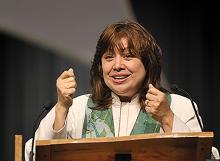bilingual

ALTHOUGH FOURTH in his high school class, Juan Martínez was never encouraged to take an AP exam or think about college. Like many other Latinos in California during the 1970s, it was assumed he would become a farm worker.
But Martínez, now vice president for diversity and international ministries at Fuller Theological Seminary in Pasadena, Calif., had a different calling; he continued his education and became a Mennonite Brethren pastor. He’s now earned two master’s degrees and a Ph.D. in theology, but Martínez still credits his father, also a pastor, for teaching him how to minister in the Latino community.
As a child, Martínez watched his father help families broken by immigration raids, support manual laborers facing exploitation, and march with other leaders in Kettleman City, Calif., to protest an enormous toxic waste dump that was created without informing the migrant workers who lived nearby. Yet Martínez’s father never considered his work “social justice,” a term he associated with churches that downplayed morality and personal salvation. For his father, said Martínez, addressing injustice against his congregation was simply “part of the daily life of the church.”
Like his father, Martínez’s ministry as a Latino pastor has involved dealing with the realities of his congregation, including the plight of migrants. But unlike his father, Martínez does not mind the label “social justice” because he believes the church exists for both community transformation and personal conversion.
“You cannot be a Latino pastor and not address the undocumented, not address the school system, not address salaries in urban or rural environments,” said Martínez. “It hits you in the face every day and we have to address the consequences.” What’s starting to change, Martínez explained, is that a new generation of Latino and Latina leaders are using “social justice vocabulary” to call attention to the problems facing their communities.
MULTIRACIAL CHURCHES are becoming more common in this country—but that doesn’t happen by chance.
A 2010 study by the Hartford Institute for Religion Research, based on a random sample of more than 11,000 congregations, revealed an increase in multiracial congregations in the U.S.—30 percent of churches reported that more than half of their members were part of minority groups.
Members of three multiracial churches in and near the nation’s capital—one Catholic, one Methodist, and one nondenominational—say that at their church “people don’t look the same, or think that much about it,” and describe their congregations as welcoming places “where you can feel God’s presence, where you can be yourself.”
Though Sunday worship time is still known as “the most segregated hour in America,” older members of churches such as Peace Fellowship Church in Washington, D.C., St. Camillus Catholic Church in Silver Spring, Md., and Culmore United Methodist Church in Falls Church, Va., remember when things started changing. As migration and demographic shifts altered neighborhoods and communities, members sought to engage in “desegregated” worship, opting to join communities that mirrored a world with different cultures and ways to praise God.

During my first year as a second-grade teacher, I struggled with classroom management. I am a soft-spoken person by nature and habit. I didn't have the experience to help me set up great rules and procedures for my students. My classroom was noisy and chaotic. I think you could hear us all around the school.
A well-meaning colleague stopped me one day after school and offered, "Trevor, you need to find your teacher voice. Most of the children at our school won't listen to you unless you yell at them. You need to show them who's boss."
After five years of teaching, I agree that it is important to find your teacher voice. I disagree, however, that your teacher voice needs to be mean and bossy. I found my voice. It’s nurturing and supportive and one that students can internalize for positive growth and change.
I thought about this teacher voice when I met 7-year-old Maria. On her first day in reading intervention classroom, she made a mistake on a skill sheet. She asked for an eraser but I said, "Don't worry if you make a mistake. You don't have to erase it. Just cross it out and fix it. I'll never be angry with you if you make a mistake. I just want you to try to fix it."